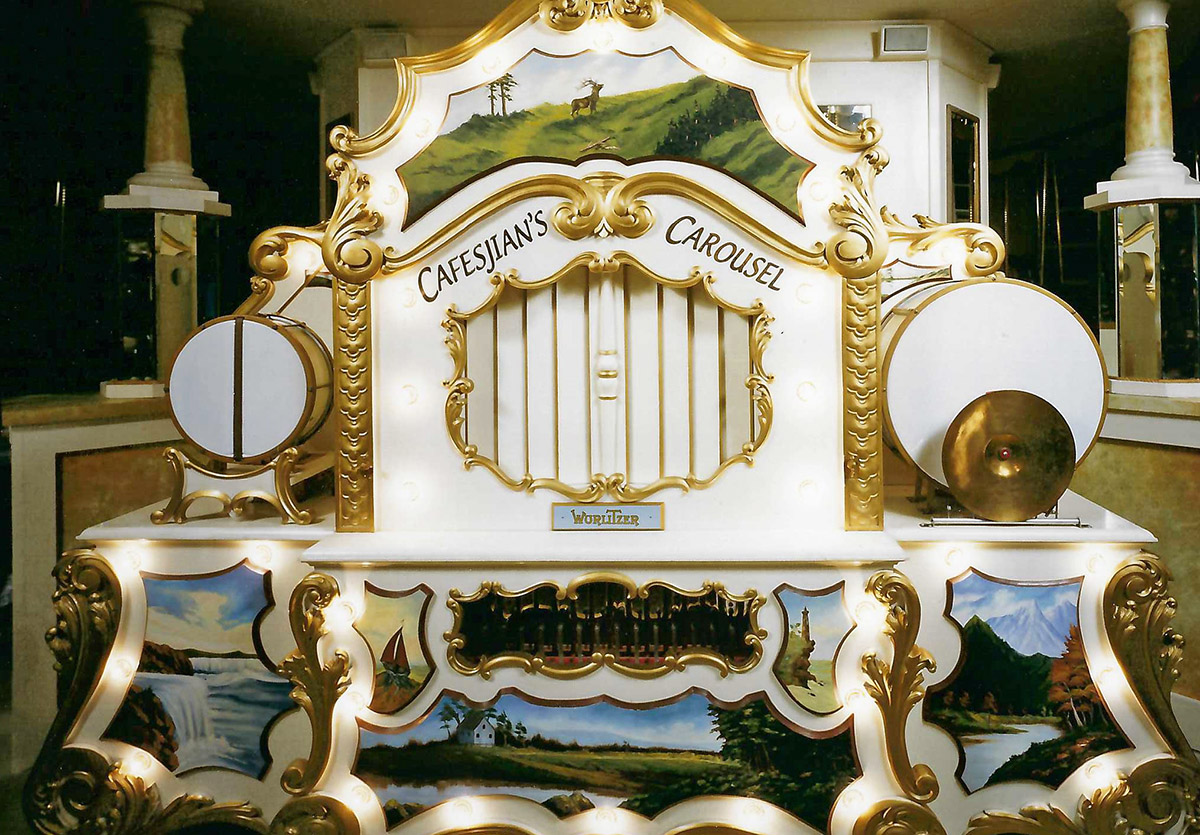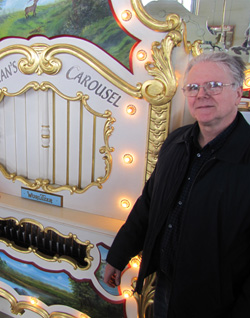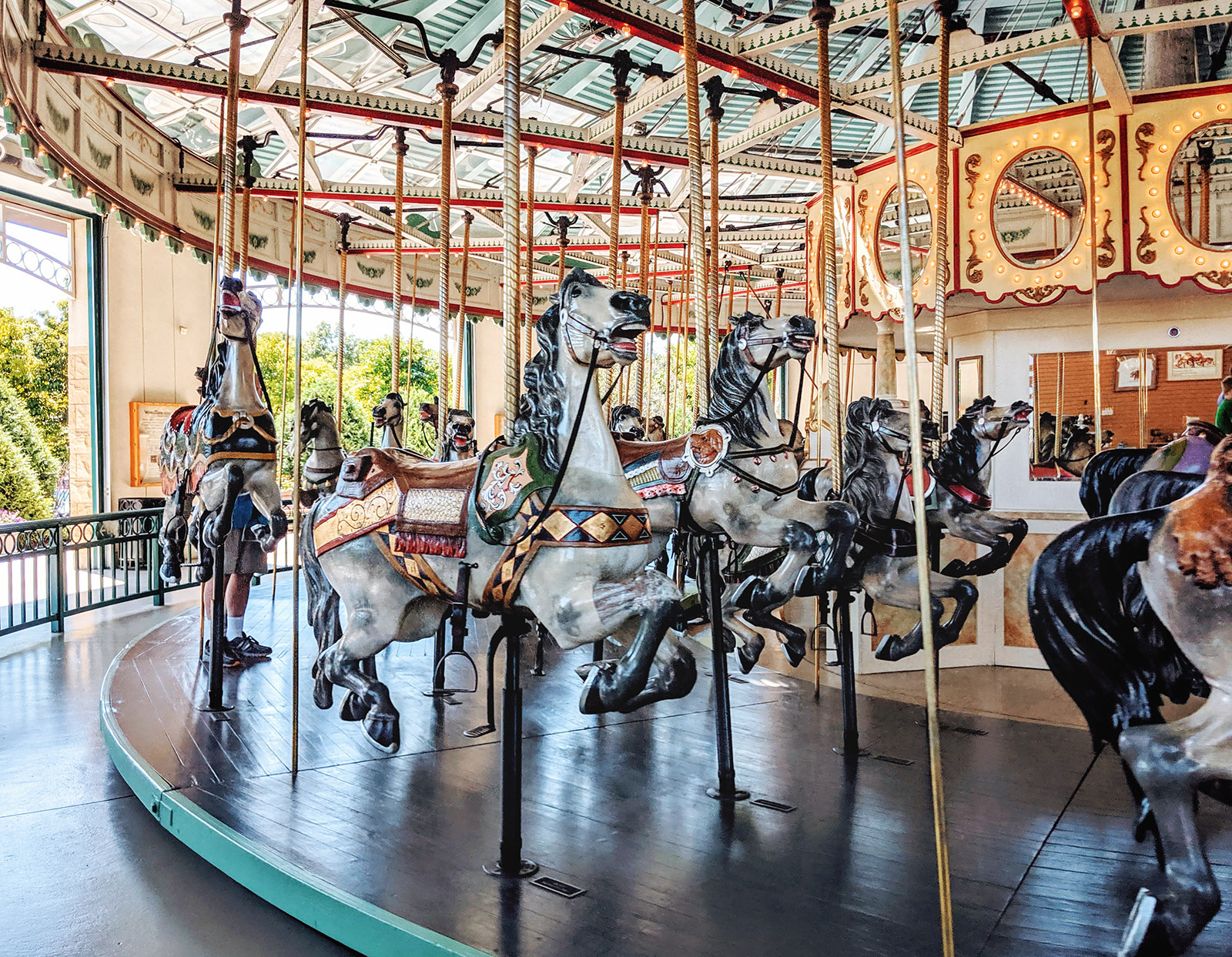Cafesjian’s Carousel boasts an exceptional Wurlitzer 153 band organ, meticulously rebuilt by Mike Merrick, longtime Our Fair Carousel volunteer and board member. The Wurlitzer was purchased in 1992 to replace the carousel’s original band organ, which was destroyed by fire in 1939. After hundreds of hours of work by Merrick, the band organ was used for a time at the carousel’s Town Square Park location. Since April 2000, it has entertained riders in Como Park.
About the Wurlitzer 153. This band organ was built by the Rudolph Wurlitzer Company of North Tonawanda, New York, which described it as an “orchestral organ suitable for three-abreast carousels.” Judging from the serial number stamped on some of the internal parts, it was built in the 1920s.
This band organ has 164 pipes consisting of trumpet, trombone, flute, violin and cello voices. The melody division has a 13-note glockenspiel, called “bells” in organ parlance. Expression–that is, variation of volume–is provided by swell shutters in the front of the organ and by extra violin and flute ranks; all of these are controlled by register perforations in the paper music roll. Wind to blow the pipes and to operate the player mechanism and percussions is provided by a 1.5 horsepower blower.
The band organ uses Wurlitzer style 150 paper rolls which are similar to player piano rolls except that these usually have 10 tunes instead of just one. In order to provide continuous music, the band organ uses dual-roll frames. While one role rewinds, the other plays. Most of the rolls in our collection are recuts from about 10 years ago. They have been punched using original Wurlitzer masters and perforating machinery. Bill Nunn, another board member, has loaned several rolls so riders and volunteers can enjoy a variety of music.
Rebuilding the Band Organ. Most band organs, including this one, were not fully chromatic. That is, many of the sharps and flats are missing. This was done to save money, but it limits the music arrangements to one or two keys. You may notice this on familiar tunes as certain parts sound out of tune. The arranger had to “borrow” a natural note to replace a missing sharp or flat. The bass register is even more severely limited; in this organ there are only three bass notes.
When OFC purchased the band organ, it had been modified several times. The front and side drum wings had been replaced, and the player mechanism had been changed from the Wurlitzer vacuum-operated roll frames to North Tonawanda pressure-operated frames. This band organ can no longer be considered “original,” and restoring it to its original condition was neither practical nor desirable. Instead, Mike Merrick (pictured at right) rebuilt it to provide our operating carousel with a high-quality, reliable, efficiently operating source of music.
Merrick’s work involved a great deal of undoing of previous modifications, some of which had been rather shoddy. He replaced the original four-bellows pump with an electric blower, both to provide a more reliable wind supply and to compensate for the extra wind demand of the player pneumatics. He also built many parts from scratch, including the bass and snare drum beater mechanisms, roll frame transfer board, register box, roll frame transmission and drive, and bell beaters. He brought the electrical system for the blower control and lights up to code.
Why Is It So Loud? You may notice as you walk through Como Park that you can often hear the music before you can see the carousel. Band organs were designed to be loud in order to attract the public to the carousel. The loud music also helps mask some of the mechanical noises of the ride. Cafesjian’s Carousel may be the smoothest-running carousel in the country, but even so, when you run the carousel without the organ playing, you can hear the whine of the motor, the rattle of brake pads and the slight rumble of the jumper gears.
The first carousel buildings were usually wood, which absorbed a lot of the sound. In addition, the ticket booth was often outside the building, so communicating between ticket seller and ticket buyer was considerably easier. The Cafesjian’s Carousel pavilion has hard steel surfaces with very little sound-absorbing material. The natural reverberation time of several seconds amplifies the sound of the band organ.



